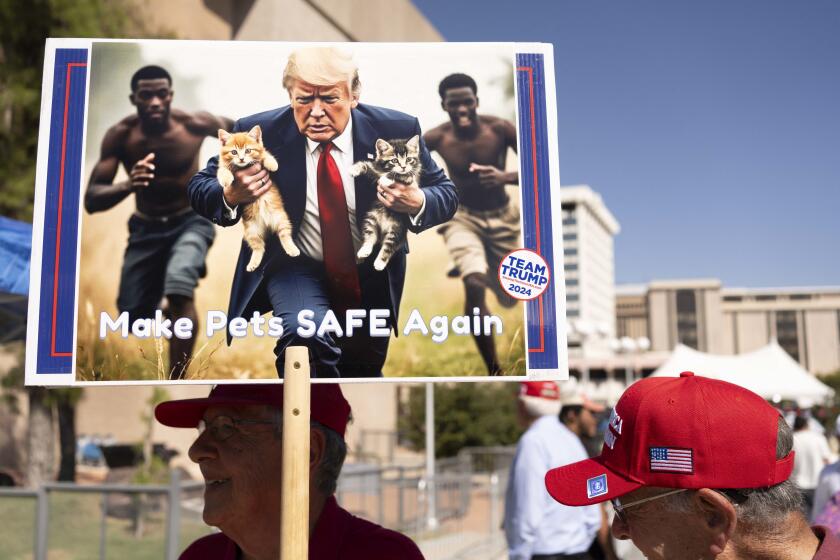Editorial: L.A. is reining in gang injunctions. That’s a good thing
Gang injunctions, pioneered in Los Angeles, are civil court orders that restrict the behavior of people whom police identify as gang members. When they are employed wisely, they can be useful tools to protect neighborhoods from the fear and intimidation perpetrated on them by criminal street gangs. When used foolishly, they become just another source of fear and intimidation, stripping residents of their basic rights to decide where to sit, whom to speak with and what to wear.
After decades in which Los Angeles indiscriminately enforced this public safety tool, City Atty. Mike Feuer is curbing the excesses and has released thousands of people from the injunctions’ net. It is a smart and welcome move.
The Times reported Monday that Feuer has sent 7,300 letters informing people they were no longer subject to gang injunctions. That’s more than three-quarters of the people who were covered, and marks a major policy shift for the city.
The reasons for the shift are open to debate. It may well be, as some city leaders argue, that the injunctions did their work, helping to persuade thousands of gang members — mostly young men — to change their ways, leave gang life and turn to more responsible and productive activities. Or it could be that gangs, though still the source of much criminal activity in Los Angeles, are no longer as pervasive and no longer pose the same level of threat that they did 20 or 30 years ago.
Mike Feuer has released thousands of people from the injunctions’ net. It is a smart and welcome move.
Or it may well be that gang injunctions had simply become a too-blunt tool in an unthinking “war on gangs” that sought to criminalize whole populations of young Angelenos in Latino and African American neighborhoods. Some of those caught up in the injunctions began to challenge their constitutionality in court.
There is indeed reason for serious concern when people who have committed no crimes but may be associated with gangs — or related to, or living near, people who are gang-associated — can be subject to arrest for doing simple things that other people in other neighborhoods can freely do, like wear whatever clothes they choose or sit on the front steps and talk with friends.
It is an example of the quandary of criminal justice. Society is vulnerable to crime waves and has a right to protect itself — but not at the expense of the basic rights and human dignity of individuals who often come under scrutiny not for anything they have done, but by their economic condition, where they live, whom they hang out with or the color of their skin. It is the same issue that arises when homicides jump in any given part of town, and police respond with pretextual car stops and body frisks to search for illegal weapons or lesser violations. Relinquishing whole neighborhoods to fear must never become acceptable, and law enforcement must respond. But neither should residents who have done nothing wrong have to constantly live in fear of the very police who were sent to help.
Surely some balancing is possible. In the case of gang injunctions, Feuer’s initiative appears to achieve it.
He, his deputies and the LAPD pored through thousands of cases to determine how appropriate it was to keep each purported gang member under injunction. Only where evidence proved beyond a reasonable doubt that the subject was an active gang member was he or she kept under one of more than 40 injunctions.
At least as important is a new policy under which a person who is going to be subjected to a gang injunction is notified in advance and given 30 days to challenge that action in court. Importantly, it is the city that must first go to court, not the person the city wants to enjoin. To settle a lawsuit over city enforcement of the curfew portion of about two dozen injunctions, the city has also stepped up with job readiness and training programs. Meanwhile, it is fighting crime with better lighting, cleaner alleys and protection for kids on their walk to and from school.
Those kinds of crime-fighting tools are far more mundane that gang injunctions, but have proved to be at least as effective, and without abridging any law abiding residents’ rights or undermining their dignity. Injunctions remain intact and part of the crime-fighting toolbox. But the city should keep honing its smaller, more delicate tools to get better results.
Follow the Opinion section on Twitter @latimesopinion and Facebook
More to Read
A cure for the common opinion
Get thought-provoking perspectives with our weekly newsletter.
You may occasionally receive promotional content from the Los Angeles Times.










